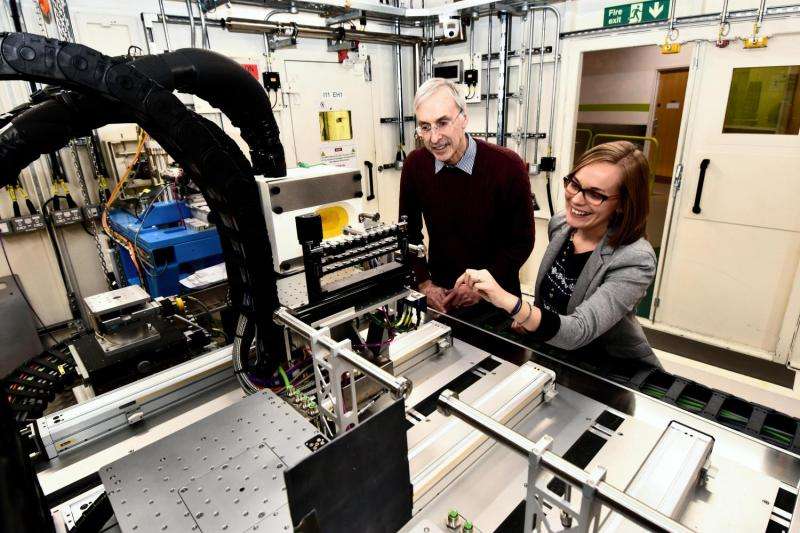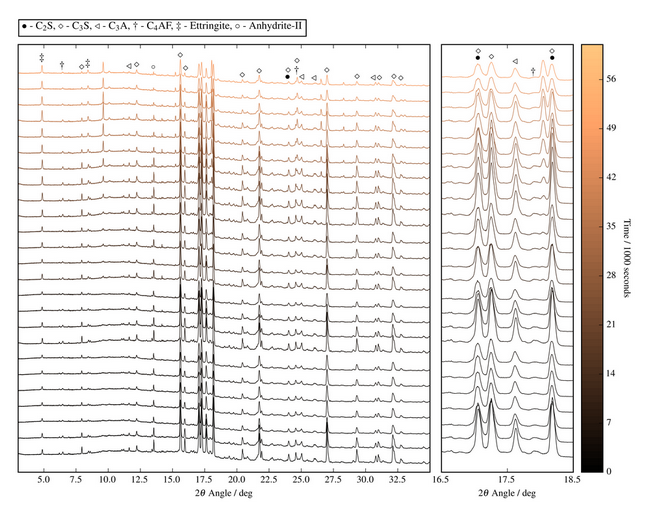Dr Claire Corkill with Prof Trevor Rayment, Physical Sciences Director Diamond Light Source. Credit: Photograph By: Sean Dillow. TheBigCheesePhotography.co.uk Diamond Light Source.
The UK's synchrotron science facility, Diamond Light Source, is a hub for renewable energy and energy recycling research, but less well known are its applications as a hub for nuclear research. Work in this area is transforming our energy future by making the nuclear fuel cycle safer, more efficient and more straightforward to use.
Scientists using the facility have been invited to present their research into radioactive waste containment at the world's largest and most prestigious science conference: the American Association for the Advancement of Science (AAAS) annual meeting, held this year in Washington D.C.
As part of a session entitled Cleaner Energy Solutions: What Can 21st Century Large-Scale Physics Deliver? a panel of three scientists will equip the audience with an understanding of pragmatic, achievable solutions to the global warming challenge in the form of nuclear fusion power, nuclear fission power and photovoltaics.
Approximately 11% of the world's electricity is produced through nuclear fission power, and it is an increasingly important factor in helping to reduce CO2 emissions in line with international targets. In recent decades, the use of nuclear energy has prevented gigatonnes of carbon dioxide being released. With proven capability as an alternative to fossil fuels, nuclear fission is likely to remain a central component of efforts to prevent future climate change.
However nuclear power generates radioactive wastes: these can be extremely toxic and very difficult to dispose of. We already dispose of the low level part of this waste safely, but a small proportion is so radioactive as to be harmful to humans unless it is isolated from them. How to deal with this waste is a topic of much debate, and scientists are currently working to develop safe and effective solutions.
Dr Claire Corkhill from the University of Sheffield is using Diamond's unique Long-Duration Experiment (LDE) facility to study the way that cement—an important material used in the storage and disposal of radioactive waste—reacts with water as it becomes hydrated over a period of hundreds of years. This important work may help to inform the UK's policy on disposal.
Claire comments: "I'm delighted to be speaking about my team's work at the AAAS. The research that the University of Sheffield is doing at Diamond is ground-breaking, and our findings could help to shape future approaches to radioactive waste disposal."
Much of the UK's nuclear research is supported by Diamond: a facility comparable to a giant microscope which scientists can use to study the atomic and molecular nature of matter. Diamond is used to support advances in medicine, technology and engineering: it is also heavily involved in helping to tackle the challenges associated with radioactive waste disposal.
Key to the UK's strategy for disposal is the plan for a Geological Disposal Facility (GDF). Under this plan, highly radioactive waste, immobilised in cement would be interred deep underground.
But it's important that we anticipate exactly what impact this approach could have on the surrounding environment. Some of this waste can take hundreds of thousands of years to decay to safe levels, and so scientists are trying to uncover the long-term result of interaction between radionuclides and their surroundings over these long timescales- that's where the Diamond synchrotron becomes particularly important.
Diamond's Director of Physical Sciences, Trevor Rayment, observes: "Timescales are crucial when it comes to nuclear research. Any facility expected to contain highly radioactive waste will need to remain functional for an extremely long period of time. Until recently, it's been impossible to use synchrotron light to study interactions that take place over extended timescales.
"But, in a world first, Diamond has engineered a long-duration experimental facility that allows users to study sample behaviour in the intense detail afforded by synchrotron light but over a two year period: much longer than has ever before been possible."
Claire is using this unique facility to study cement's reaction with water over an extended period of time. If we plan to use cement in our GDF then we need to know how it will interact with its environment over many thousands of years. Examining changes over this period should make it easier to predict what might happen over a much longer time.
Claire's research is transforming the way we view the challenge of nuclear waste disposal, and she will soon be presenting this pioneering work to other leading figures in the science community at the AAAS in February.
Whilst the 2-year long experiment is still ongoing, the work has already yielded some exciting results. Claire has discovered that a new cement material for the GDF, developed by her research team, forms a number of mineral phases known to sorb highly radioactive elements, such as technetium-99. Claire comments: "Armed with the knowledge that these phases form, and knowing how quickly, supports the use of our new cement material in the GDF. We hope that these results will influence the design of the GDF and help improve it's long term safety."
Reflecting on this research, Claire comments: "The clean-up and safe disposal of our nuclear waste legacy is a significant challenge and it's fantastic to be involved in such an exciting area of research at what is truly a pivotal time for the field."
"The pattern of peaks identified in cement essentially act as a "fingerprint" telling us which cement minerals are present. The really exciting thing about using the LDE facility is that we are able to obtain very high resolution, time resolved patterns, something that is not possible using a normal laboratory instrument."
The wider context: further nuclear research taking place at Diamond
Trevor adds: "A number of institutions are currently exploiting analytical tools at Diamond for research into nuclear energy. For example, the University of Manchester explore radioactive contamination of the environment both inside and beyond the UK's planned GDF, in environments as diverse as nuclear fuel ponds, contaminated land and naturally radioactive sites, whilst the University of Bristol is studying the fallout from the Fukushima disaster and opportunities to improve the radioactive waste clean-up process."
The Manchester group are using one of Diamond's spectroscopy beamlines, B18, to study how radionuclides, including transuranic materials, which arise from nuclear processes, combine and interact at the atomic level with natural minerals and microbes in the earth. In order to protect the surrounding environment, we have to understand the impact that radioactivity in the waste could have as the disposal facility gradually evolves over millennia and their work is highlighting that both minerals and microbial activity can actually act to provide a barrier to radionuclide migration in many systems.
Meanwhile, Bristol recently used one of Diamond's spectroscopy beamlines, I18, to study the residual contamination left over from the Fukushima nuclear accident that took place in Japan in 2011. An understanding of contamination of this sort on a molecular level can help us to better understand how to manage and contain radioactive waste.
Bristol's research has also helped towards identifying a means of reducing the costs and timescales involved in the disposal of intermediate level waste. Their efforts have supported the decision to make the process significantly cheaper and quicker to carry out - good news for the future of nuclear energy.
Provided by Diamond Light Source






















